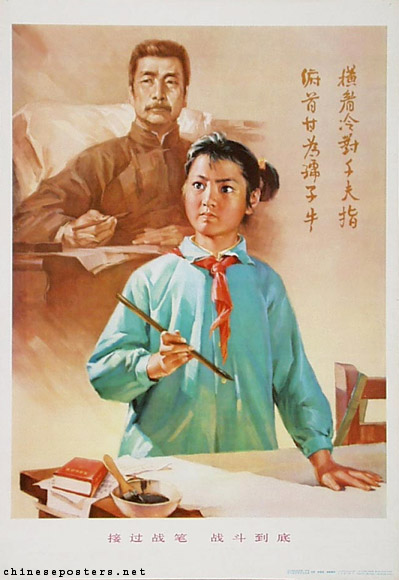|
|

楼主 |
发表于 2008-9-14 23:08
|
显示全部楼层

7.
Xiao Zhenya, Liu Enbin
1975, June
Take over the brush of polemics, struggle to the end
Jieguo zhanbi zhandou daodi
Renmin meishu chubanshe, print no. 8027.6075
Call number: BG E3/753
No matter how many books had been destroyed during the Cultural Revolution, no matter how much learning had been derided and how many intellectuals had been prosecuted, the Communist Party remained convinced of the mobilizational effects and effectiveness of literacy. Some intellectuals, in particular Lu Xun (hovering in the background in a characteristic pose), continued to be held up as an inspiration for young people.
The Chinese text in the background is a famous couplet from a poem by Lu Xun ("Self-Mockery", 1932), in his calligraphy. It reads "Coolly I face a thousand pointing fingers, Then bow to be an infant's willing ox" (Translation Bill Jenner, 1982). In his Closing Remarks at the 1942 Yan'an Forum on Literature and Arts, where guidelines for artistic production where set that basically are still in force, Mao said that Lu's couplet should become the motto of the CCP. In his analysis, the 'thousand men' were the enemy, and the 'infant' stood for the proletariat and the masses of the people, for which the CCP should wear itself out in its service with no release until death.
Lu Xun (pen name of Zhou Shuren, 1881-1936) played a seminal role in the world of Chinese literature and arts in the first decades of the 20th century. He was trained in the Jiangnan Naval Academy and the Sendai Medical School (Japan). Upon his return to China in 1909, he taught science in school, and later served as an official in the Ministry of Education. In 1918, he joined the May Fourth (New Culture) Movement by having his "Diary of a Madman" (Kuangren riji) published in New Youth Magazine (Xin qingnian). Both the style and the contents of this story had great influence on other May Fourth writers. Lu continued to publish short stories ("The True Story of Ah Q", the impressive "Medicine", and " Kong Yiji"), prose poetry and zawen (miscellaneous essays). These earned him the reputation of being a shrewd and incisive observer and commentator of the times. Lu did not limit himself to creating literature that reflected his increasingly radical ideas about Chinese society. Inspired by European woodcut artists like Käthe Kollwitz, he introduced techniques and socially relevant subject matter to likeminded young artists in China. This in turn would have an important influence on the propaganda posters produced later under the CCP. In short, Lu Xun became a radical, while maintaining his independence from both the Nationalists and the Communist Parties. Nonetheless, Mao Zedong canonized Lu Xun as the intellectual forefather of the Revolution, as a trailblazer in the early struggles of the CCP. Although not a Party member, he has been considered a true Marxist-Leninist. Since 1949, Lu's name and his writings have been frequently used in the various struggles against enemies of various colors. |
|